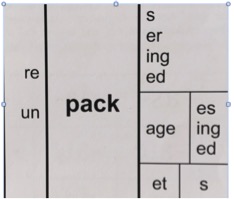Language is an intricate system that allows us to communicate and express our thoughts and ideas. Morphology, the study of word formation and structure, provides a window into the world of prefixes, suffixes, bases, and more. Effective instruction in morphology can significantly enhance vocabulary acquisition, reading comprehension, and language proficiency.
Morphology instruction should begin by fostering an awareness of morphemes, the smallest meaningful units of language. Students should be introduced to common prefixes, suffixes, and bases, accompanied by clear explanations of their meanings and functions. Teachers should provide explicit explanations and modeling of how morphemes work in different words.
One of the primary benefits of morphology instruction is its impact on vocabulary growth. By understanding how words are formed, students can decipher the meanings of unfamiliar words encountered in reading and expand their vocabulary bank.
When teaching morphology, one must also consider semantics, orthography, and phonology as integral parts of understanding the structure and meaning of language. Each component contributes to the overall comprehension and production of words and sentences. When teaching these linguistic aspects, adopting an integrated approach that highlights their interconnections is crucial.

Source: J. Kirby, Peter N. Bowers, Morphological instruction and literacy
Morphology and Semantics
Morphology contributes to semantic understanding by adding prefixes or suffixes that modify the meaning of a base. Educators should emphasize the relationship between morphological changes and shifts in word meaning. They can provide examples of how adding or altering morphemes can change the semantic category (e.g., turning a verb into a noun) or alter the overall meaning of a word. Activities such as word analysis, semantic mapping, and vocabulary development exercises can help students grasp the connection between morphology and semantics.
Morphology and Orthography
Orthography refers to the spelling and writing system of a language. Morphology significantly impacts orthography because morphological changes often affect the spelling of words. Teaching morphology alongside orthography can help students understand spelling patterns and rules. By recognizing morphemes within words, students can identify spelling patterns associated with specific prefixes, suffixes, or bases. For instance, they can learn that adding “-ed” to a verb typically indicates the past tense. Explicit instruction, word sorts, word families, and spelling exercises can enhance students’ understanding of the relationship between morphology and orthography.
Morphology and Phonology
Phonology refers to the sound system of a language. The English language is morphophonemic, meaning that the spelling of English words is influenced by both phonics and morphology. Teaching morphology and phonology together allows students to understand how each of these components plays a role in spelling and pronunciation. For instance, the plural marker “-s” in English is pronounced differently depending on the final sound of the word to which it is attached. Teachers can engage students in activities that involve analyzing the phonological changes caused by morphological processes, such as assimilation, vowel harmony, or consonant alternation.
Strategies To Unlock Word Formation Skills
Unlocking word formation skills requires the application of various morphological strategies. These strategies enable learners to analyze and decode the structure and meaning of unfamiliar words. Here are some morphological strategies to help unlock word formation skills:
Recognizing Affixes
Developing the ability to identify common prefixes and suffixes is a valuable skill for understanding word formation. Encourage learners to recognize affixes and understand their meanings. Provide lists of common prefixes (e.g., un-, re-, pre-) and suffixes (e.g., -able, -ful, -less) along with their definitions. Engage students in activities like word analysis, where they identify and highlight affixes in given words. This strategy helps learners infer the meaning of unfamiliar words by focusing on the known affixes.
Analyzing Bases
Bases are the building blocks of meaning from which words are formed. Encourage students to analyze basesand understand their core meanings. By identifying familiar bases and linking them to related words (e.g., identifying the Latin base rupt in eruption and disrupt), learners can make educated guesses about the meaning of unfamiliar words. Provide word lists with shared bases, and encourage students to explore their definitions and connections. This strategy strengthens their word formation skills and expands their vocabulary.
Understanding Word Families
Word families consist of words derived from the same base, often by adding affixes or other morphological changes. Encourage students to explore word families to deepen their understanding of word formation. Provide word charts or graphic organizers that showcase the various forms of a base (e.g., act, actor, action, active). This strategy helps learners recognize patterns and make connections between related words, facilitating comprehension and vocabulary expansion.

Source: Neil Ramsden, word matrix chart
Exploring Borrowed Words and Loanwords
Languages often borrow words from other languages, resulting in loanwords. Encourage students to explore borrowed words and their origins. This strategy helps learners understand the influences and patterns of word formation across languages. Introduce loanwords from various cultures and languages, and discuss their meanings and etymology. This approach broadens students’ linguistic horizons and enhances their understanding of word formation principles.
Consistent practice and exposure to various words and word formation patterns are essential for mastering morphological strategies. By incorporating these strategies into instruction and providing ample opportunities for application, learners can unlock word formation skills and become proficient in analyzing and understanding the structure and meaning of words.
Are you looking for professional development to expand your knowledge regarding morphology? IMSE Impact Morphology+ Structured Literacy Professional Development and Curriculum provides a complete understanding of morphology, fluency, vocabulary, and comprehension and how to apply it in the classroom. Sign up for training today to make an impact in your classroom tomorrow!
Resources:
- https://www.readingrockets.org/blogs/shanahan-literacy/what-should-morphology-instruction-look
- The Effects of Morphological Instruction on Literacy Skills: A Systematic Review of the Literature
- Teaching Morphology to Improve Literacy
Please connect with us on Facebook, Twitter, Instagram, LinkedIn, and Pinterest to get tips and tricks from your peers and us. Read the IMSE Journal to hear success stories from other schools and districts, and be sure to check out our digital resources for refreshers and tips.
